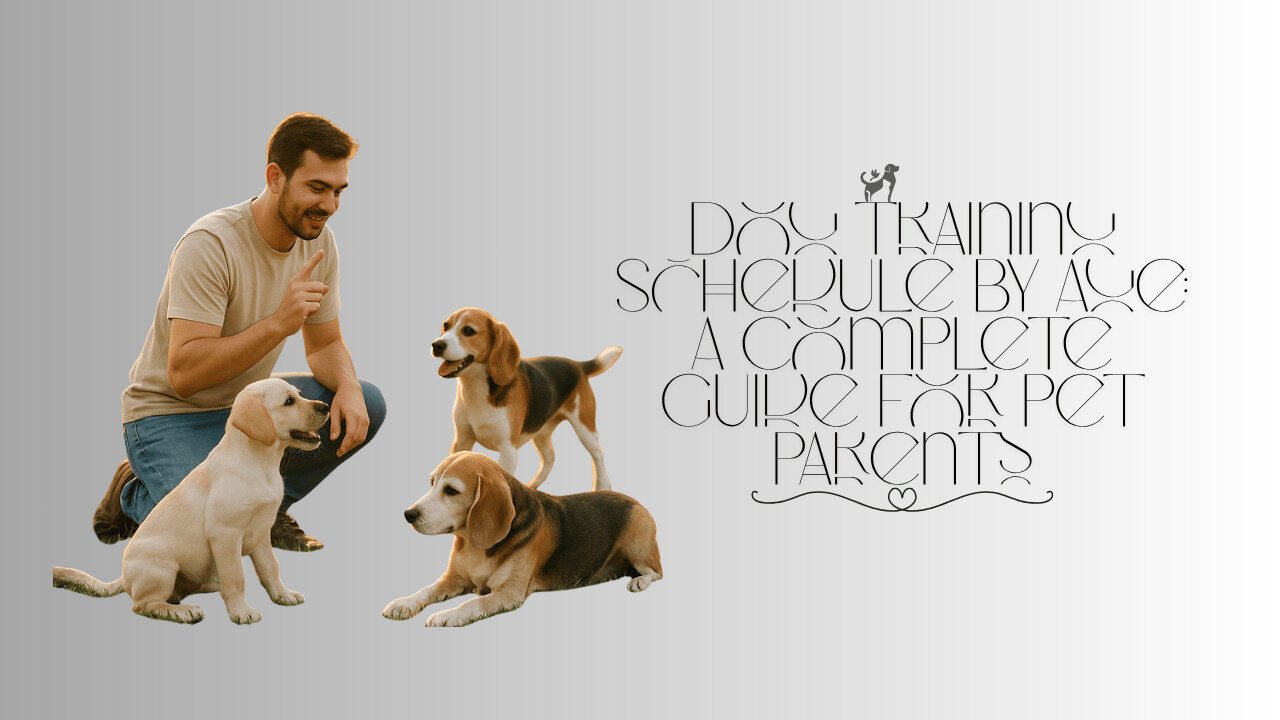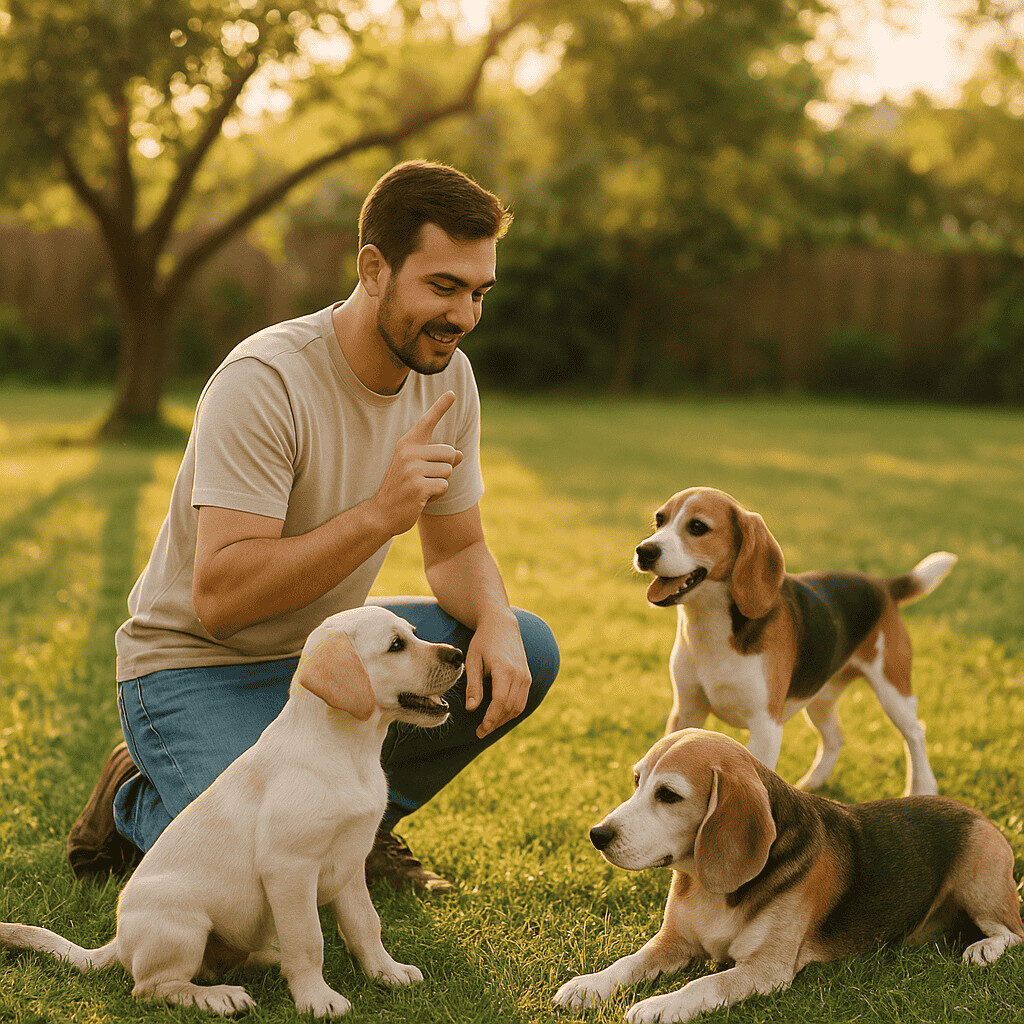Most pet owners don’t realize how much a dog’s age impacts their ability to learn. Just like kids, dogs have developmental milestones. Training a 12-week-old puppy is not the same as training a two-year-old rescue dog. When I adopted my lab mix, Benny, at six months, I had to completely shift my training style from what I used with my older beagle. That’s why having a Dog Training Schedule by Age is so important. Understanding your dog’s age and behavior stage is crucial for setting realistic goals and avoiding frustration.
Training Schedule by Dog Age Group
Let’s break down what training looks like at each stage of your dog’s life.
Puppy Training Schedule (8–16 Weeks)
Goal: Build trust, teach foundational commands, and introduce positive social experiences.
Daily Time Commitment: 5–10 minute sessions, 3–5 times a day
What to Focus On:
- Name recognition and recall (“come”)
- Potty training and crate acclimation
- Handling & grooming tolerance
- Bite inhibition
- Socialization (people, dogs, textures, sounds)
Sample Schedule:
| Time | Activity |
|---|---|
| 7:00 AM | Potty + short leash walk |
| 8:00 AM | Meal + 5-min training session |
| 10:00 AM | Nap + crate time |
| 12:00 PM | Potty + play + training |
| 3:00 PM | Short training + social outing |
| 6:00 PM | Meal + leash manners |
| 9:00 PM | Calm training + crate routine |
Pro Tip: Puppies have short attention spans. Keep it positive and end on a win.
Juvenile Training (4–6 Months)
Goal: Reinforce good habits and expand basic obedience.
Daily Time Commitment: 15–20 minutes per session, 2–3 times a day
What to Focus On:
- Sit, down, stay, leave it
- Leash walking without pulling
- Continued socialization
- Intro to alone time (to prevent separation anxiety)
I found this stage surprisingly tricky. Benny suddenly “forgot” commands he had mastered. Turns out, it’s totally normal — like a teenage rebellion phase. Stay consistent and patient!
Adolescent Training (6–18 Months)
Goal: Maintain consistency through the “teen” phase.
Daily Time Commitment: 20–30 minutes total, split into 2 sessions
What to Focus On:
- Distraction-proofing learned commands
- Impulse control exercises
- Advanced recall training
- Addressing problem behaviors like jumping or barking
According to the American Kennel Club, adolescence is when dogs test boundaries. This is prime time for behavior to stick—for better or worse.
Helpful Exercises:
- “Leave it” with high-value distractions
- Long-line recall in the park
- Settle on a mat with duration training
Adult Dog Training (1.5 – 7 Years)
Goal: Polish manners and introduce mental challenges.
Daily Time Commitment: 15–20 minutes daily or every other day
What to Focus On:
- Reinforce reliability of all commands
- Teach fun tricks or agility basics
- Mental stimulation (puzzle toys, scent games)
- Curb any lingering behavioral issues
Adult dogs can absolutely learn new tricks. I taught Benny to ring a bell to go outside — at age 3. He loved having a “job” to do.
Sample Weekly Plan:
- Monday: Leash manners walk
- Tuesday: Trick training (e.g., roll over)
- Wednesday: Scent work indoors
- Thursday: Quiet settle in cafe
- Friday: Off-leash recall in yard
- Weekend: Explore a new trail
Senior Dog Training (7+ Years)
Goal: Keep the brain engaged and body active without overexertion.
Daily Time Commitment: 10–15 minutes, low-intensity
What to Focus On:
- Gentle cognitive games
- Refresh basic commands
- Support for mobility issues
- Positive interaction routines
My neighbor’s senior spaniel still enjoys hide-and-seek games at age 12. It keeps her mind sharp, even with limited mobility.
For dogs with health changes, consult your vet. You can still train gently, using soft treats and non-strenuous games.
Tips for Success at Every Stage
1. Keep It Short and Sweet
Dogs learn best in brief, fun sessions. Overtraining leads to frustration.
2. Reinforce, Don’t Repeat
Don’t keep saying “sit” if your dog ignores it. Reset, reward the try, and build clarity.
3. Use Real-Life Rewards
Training doesn’t only happen during “training time.” Ask for a “sit” before meals or a walk.
4. Be Consistent
If jumping isn’t allowed on Monday, it shouldn’t be on Friday. Everyone in the house must follow the same rules.
5. Use Age-Appropriate Tools
Puppies need soft collars; older may need orthopedic beds for comfort during sessions.
For more training tools and lifestyle tips, check out our home base at Fluffze.com
FAQs: Dog Training by Age
How early can you start training a puppy?
As early as 8 weeks. Focus on basic manners and socialization. Formal obedience can start around 12 weeks with positive methods.
Is it too late to train my 2-year-old dog?
Not at all! Adult dogs are highly trainable — sometimes more than puppies due to longer attention spans.
How often should I train my dog?
Ideally daily in short bursts. Puppies may need multiple mini-sessions, while adult dogs do well with 15–20 minutes per day.
What’s the hardest age to train a dog?
Many pet parents struggle during adolescence (6–18 months) due to testing boundaries and hormonal changes.
Do senior dogs need training?
Yes, but with modifications. Training provides mental enrichment and keeps them engaged and alert.
Final Thoughts + CTA
Training isn’t a one-time event — it’s an evolving journey that should adjust as your dog grows. With the right approach and age-specific strategies, you’ll raise a confident, well-mannered companion.
Got a puppy, teenager, or senior dog at home? Save this guide, share it with fellow pet parents, and start building a training schedule that works for your dog’s age and stage.
Want more actionable tips? Check out our full collection of pet advice at Fluffze.com.
Written by
Written by Sarah Bennett, pet lover & contributor at Fluffze.
Sarah is a lifelong dog mom, certified positive reinforcement trainer, and Fluffze’s resident expert on all things canine behavior.
Related Articles:
Safe Flea Treatment for Puppies Under 12 Weeks
How to Train a Dog to Use a Litter Box: Simple Steps






